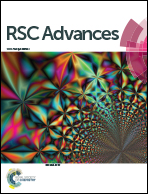Reduced graphene oxide/gold tetraphenyl porphyrin (RGO/Au–TPP) nanocomposite as an ultrasensitive amperometric sensor for environmentally toxic hydrazine†
Abstract
A gold tetra phenyl porphyrin/reduced graphene oxide (RGO/Au–TPP) nanocomposite film modified glassy carbon electrode (GCE) was prepared for the trace level detection of hydrazine. The prepared nanocomposite was characterized by scanning electron microscopy, X-ray diffraction studies, transmission electron microscopy, ultraviolet-visible spectroscopy, infrared spectroscopy and Raman spectroscopy. Electrochemical studies of the modified electrode were carried out by the cyclic voltammetry and an amperometric (i–t) method. The RGO/Au–TPP/GCE exhibited enhanced electrocatalytic activity towards the detection of hydrazine. The detection limit was 3 nM, the linear range was between 20 nM to 198 μM L−1, and the sensitivity was 2.266 μA μM−1 cm−2. The modified electrode also selectively detected hydrazine in the presence of 500 fold excess concentrations of other interfering ions. The practical applicability of the sensor was addressed in different water samples which showed satisfactory recoveries. Moreover, the sensor showed acceptable repeatability, reproducibility and higher stability.


 Please wait while we load your content...
Please wait while we load your content...